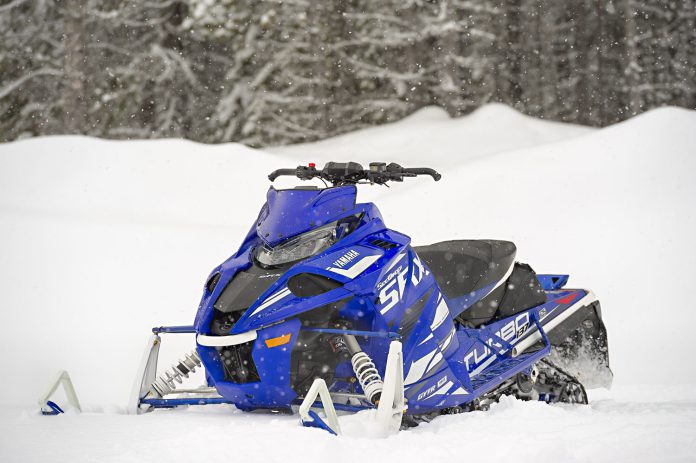The SRX has a few distinguishing features that carve it out from the mainstream. In a move many questioned at its announcement, Yamaha has lowered the SRX’s ride height a total of an inch. In today’s world of long travel suspension and deep stroking shocks, this seems like a step backwards. Yamaha figured out a way to keep the SRX’s center of gravity low, low and still deliver good ride results. Yes, the answer is technical and… expensive.
Up front, the engineers chose dual rate springs to deal with the increased sag built-in and then added “low preload” rear shocks. Check the specs and you’ll find the SRX actually has the same amount of suspension travel as other SideWinders but when you’re sitting on it, the suspension sag drops your butt an inch deeper into its travel.
The end result is that the sled feels like it’s sitting lower – and in fact, is – but you still have the same amount of suspension movement when the sled is static. Why do this? Like we said, a lower sled has a lower CG so its mass is closer to the ground. But more than that, this SRX rails corners and keeps the skis planted without a lot of ski-lift as its suspension unloads right to left and back again.
In technical sections of trail the lower CG also tends to counter the feeling of top-heaviness often attributed to heavier 4-strokes especially with turbocharger plumbing.
Yamaha conspired with Fox to develop the IQS (Intelligent Quick Shift) shock, which allows the rider to toggle three different suspension settings from the handlebars that can upgrade or reduce compression dampening within a second. Although this is fully a rider negotiated system, meaning the rider has to make the adjustment and judge whatever setting is needed depending on the terrain, it’s very quick-acting and effective. The on-the-fly adjustments are immediately noticeable and the ride change is significant.
Just so you know, Yamaha has dealt with the engine performance issue not by increasing boost from the turbo but by adding a new helix to the secondary clutch. The steeper helix accelerates the SRX harder and backshifts more aggressively to assist with power transitions – like when you’re too hot going into a corner, brake hard and then want to get back into the power quickly to hit the apex of the corner.
The Apex, with its non-roller primary, struggled with this issue and often had a “rubber band” feel when you wanted the clutches to hook up right now! It’s no surprise aggressive secondary clutching would offer more performance given the enormous torque the turbo 998 can generate.
So we know the person who wants an SRX wants the max Yamaha offers. Based on its dealer invoice, that owner shouldn’t have to and won’t tolerate compromise – and won’t have to – thanks to IQS. There will be a performance improvement, based on the revised clutching but there is one caveat that seems contrary to all of this.
Yamaha has chosen to use a one-inch track on this model. We’re absolutely positive this has to do with bragging rights about being the fastest snowmobile ever. Obviously, the one-inch track was a compromise made to gain top speed. Sure, it won’t hook up as well as a deeper track but it is definitely faster on hardpack. One focus, one purpose , total compromise to everything but top speed.
A low-ply one-incher generates way less friction than a heavier 1.6 (the minimum depth track we feel is required here) and will accelerate harder and maintain blistering top end.
We honestly have to question whether or not this sled will hook up on any surface without about 100 traction studs. This adds both weight and friction and pretty much negates the benefits of the shallower track. Our experience with all SideWinders and Turbo Cats tells us the biggest issue with these sleds is traction. There’s so much power on tap here you’re simply dreaming if you think you can get full performance potential without studs – and lots of ’em.
Problem is, Yamaha has had a longstanding policy about track warranties where studding is involved. As of this writing, the company’s stance is the same – no dice. Here’s what owners may wish to do: Forget about warranties and stud the track anyway. Just don’t complain if you peel the track off the sled in 5,000 miles.
Sure, it’s a compromise, but there’s always a price attached to being the fastest.



